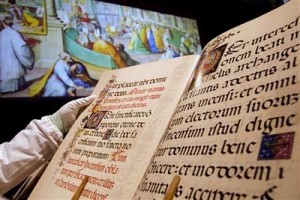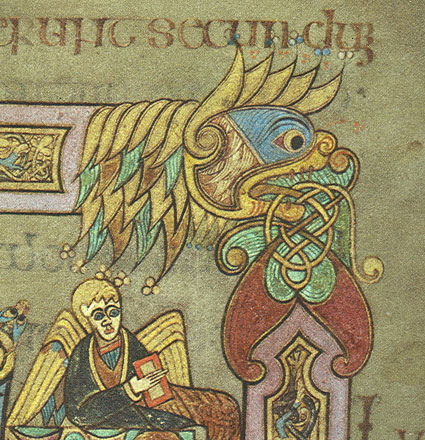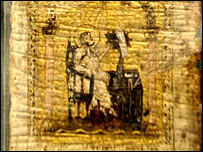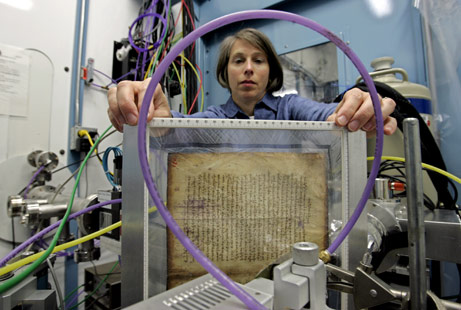Category — Manuscript Science
10th Annual Marco Symposium at The University of Tennessee March 1-3 2012
Be there or be square! I’ll be there on and off as time permits.
From The University of Tennessee’s events calendar:
“Grounding the Book: Readers, Writers, and Places in the Pre-Modern World”
The 2012 Marco Symposium, co-organized by Thomas E. Burman (history), Maura Lafferty (Classics), and Anthony Welch (English) will bring together up to ten scholars from a range of disciplines to explore the complex interaction between pre-modern writers and readers, their books, and the places-libraries, museums, monasteries, university classrooms, the courts of patrons-where they wrote and read them. A substantial amount of recent scholarship in the interdisciplinary field of the history of reading has made clear the countless ways in which understanding the materiality of texts sheds fascinating light how on those texts were read and deployed. The layout of a copied or printed page, the other works with which a text appears in a book, the marginalia that so frequently appears in margins: all these and many other aspects of the ‘material text’ open valuable windows through which we can catch glimpses of writers and readers interacting with texts.
Read the rest here.
February 21, 2012 Comments Off on 10th Annual Marco Symposium at The University of Tennessee March 1-3 2012
Wonderful Video on Making Illuminated Manuscripts from The J. Paul Ghetty Museum
February 14, 2012 1 Comment
CBS News 60 Minutes Visits the Vatican Library
 I hope everyone stayed tuned to CBS after the Masters yesterday to watch 60 Minutes. They did a marvelous piece on the Vatican Library with Morely Safer as host. In case you missed it, video is available at CBS News.
I hope everyone stayed tuned to CBS after the Masters yesterday to watch 60 Minutes. They did a marvelous piece on the Vatican Library with Morely Safer as host. In case you missed it, video is available at CBS News.
April 11, 2011 Comments Off on CBS News 60 Minutes Visits the Vatican Library
The Book of Kells in the News

There may be no more famous example of an illuminated manscript than the Book of Kells. While it is well known as one of the most beautiful surviving illuminated manscripts, surprisingly, very little is actually known about the manuscript and its origins. Finally, modern science will be used to learn more about this treasure. From the Dublin Journal as reported in the New York Times:
Experts at Trinity College in Dublin, where the Book of Kells has resided for the past 346 years, are allowing a two-year laser analysis of the treasure, which is one of Ireland’s great tourist draws.
The 21st-century laser technology being used, Raman spectroscopy, encourages hopes among those with a romantic view for an ecclesiastical intrigue like “The Da Vinci Code†or “The Name of the Rose.â€
But the precise subjects are more mundane. The laser will study the chemicals and composition of the book, its pigments, inks and pages of fine vellum. Experts estimate that 185 calves would have been needed to create the vellum on which the art and scriptures were reproduced.
This news happens to coincide with the opening of The Medieval Scriptorium’s on-line gallery of images from the Book of Kells. I have to admit that the gallery is not complete. I haven’t had time to finish all of the captions for the images but I decided to introduce it in this post in light of the recent story referenced above.
[tags]Book of Kells, illuminated manuscript, celtic, calligraphy[/tags]
May 29, 2007 1 Comment
Medieval Scribe, John Myronas, a 13th Century Parchment Recycler
 Yet another layer of history has been discovered in a Christian prayer book attributed to John Myronas. The most recent discovery is the third layer of text discovered in this recycled 13th century manuscript. In 2002, modern multi-sectional and multi-spectral imaging methods discovered greek writings from the 4th century. An article in the National Geographic News describes the earlier find:
Yet another layer of history has been discovered in a Christian prayer book attributed to John Myronas. The most recent discovery is the third layer of text discovered in this recycled 13th century manuscript. In 2002, modern multi-sectional and multi-spectral imaging methods discovered greek writings from the 4th century. An article in the National Geographic News describes the earlier find:
In 2002 researchers had uncovered writings by the mathematician Archimedes and the fourth-century B.C. politician Hyperides.
Last year one of the pages was found to contain a famous work by Archimedes about buoyancy that had previously been known only from an incomplete Latin translation.
A third layer has been been revealed and the details were presented today at the meeting of the American Philosophical Society by Reviel Netz and Roger Easton. From the BBC:
A series of clues, such as spotting a key name in the margin, led the team to its conclusion.
“The philosophical passage in the Archimedes Palimpsest is now definitely identified as a relatively early commentary to Aristotle’s Categories,” said Professor Netz.
He said that Aristotle’s Categories had served as the foundation for the study of logic throughout western history.
Further study has revealed the most likely author of this unique commentary is Alexander of Aphrodisias, Professor Robert Sharples from the University College London told BBC News.
If this is the case, he said, “it gives us part of a commentary previously supposed lost by the most important of those ancient commentators on Aristotle”.
From the National Geographic News:
n the 10th century a scribe had copied the ancient Greek manuscripts from papyrus scrolls onto parchment—thin leaves of treated animal skin.
Later the writing was washed out using a solvent such as orange juice and overwritten with new text—a process known as palimpsesting.
“In those days, parchment writing materials were so valuable that they were commonly reused when the book was considered out of date or if the subject was judged inappropriate or less valuable,” Roger L. Easton, of the Rochester Institute of Technology, wrote in an email.
By the 12th century, pages from five different earlier works had been erased, overwritten, and compiled into a Christian prayer book, the Euchologion—what is now called the Archimedes Palimpsest.

As always, books are multi-layered treasures. I wonder what else might be discovered in this 13th century prayer book?
[tags]Euchologion, Archimedes Palimpsest, Aristotle, Christian Prayer Book, 13th century, John Myronas, Philisophical Society, Archimedes, parchment, illuminated manscript[/tags]
April 26, 2007 Comments Off on Medieval Scribe, John Myronas, a 13th Century Parchment Recycler


